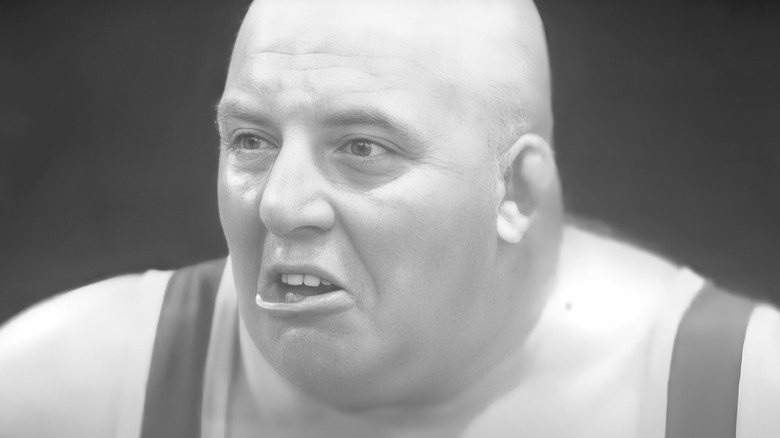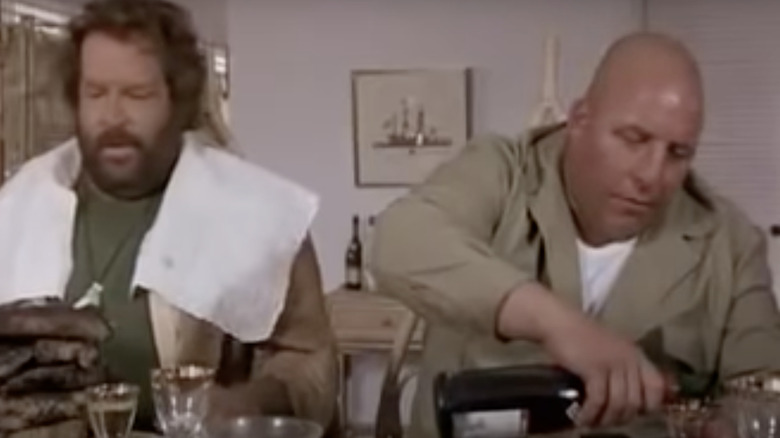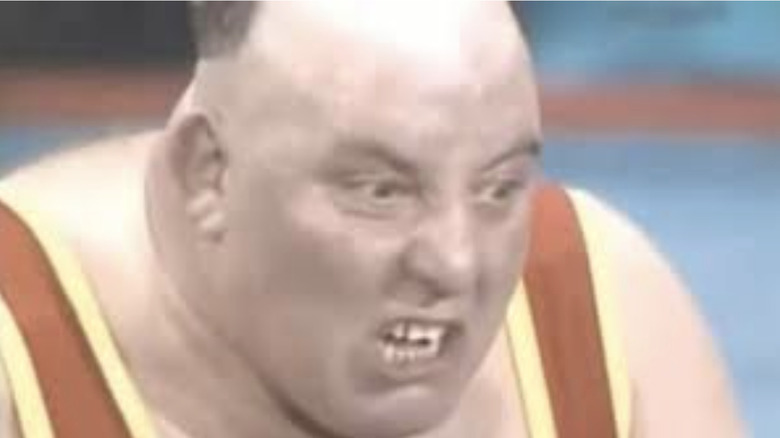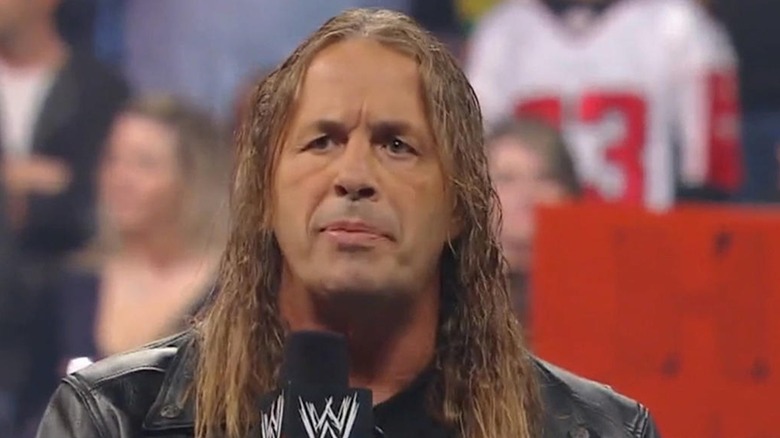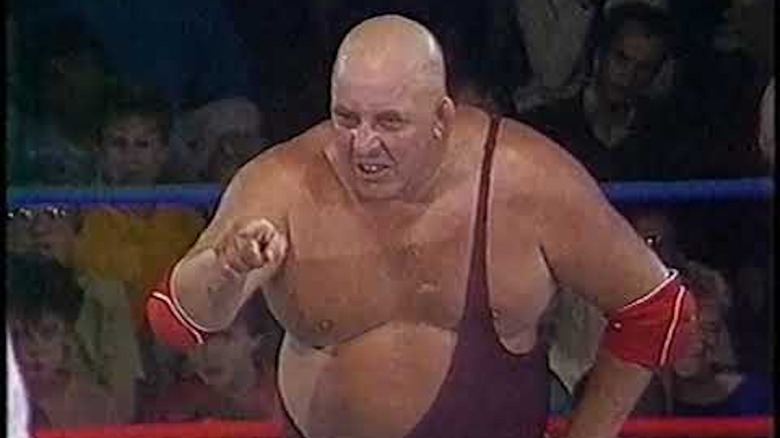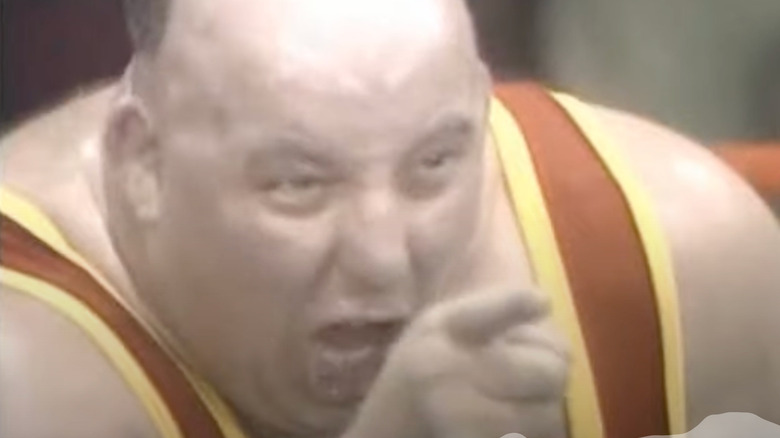The Tragic Story Of King Kong Kirk
It has often been said that professional wrestlers lay their bodies on the line and put their very lives at risk in the name of entertaining the crowd. Unfortunately, there have been several instances over the years where wrestlers paid the ultimate price while performing their craft, and such was the case with Malcolm "King Kong" Kirk, who died during a match in Great Yarmouth, Norfolk, England in 1987.
Kirk is probably not the first "King Kong" most wrestling fans think of, thanks to his career primarily taking place in the United Kingdom while King Kong Bundy rose to prominence in the United States in the same era. Like Bundy (although on a bit of a lesser scale), Kirk was a huge man, standing 6'1" and being billed anywhere between 310 and 350+ pounds in his career. Kirk's athletic acumen and toughness outside of wrestling, having played professional rugby and worked as a coal miner prior to his career inside the ropes, was impressive enough that he didn't portray much of a gimmick, intimidating foes simply with his presence.
Holding his own amongst big man contemporaries, Kirk worked as a heel and competed with a multitude of legendary names over the course of his career. It ended in tragedy on August 23, 1987, in a tag match featuring Kirk and King Kendo against Greg Valentine and the most popular babyface in the region at the time, Shirley "Big Daddy" Crabtree. He is remembered as an agile and menacing big man in an era when heavyweights and superheavyweights ruled. Let's take a look back at the life, career, and tragic death of Malcolm "King Kong" Kirk.
Outside of Wrestling
A native of Streethouse, West Yorkshire, England, Malcolm Kirk worked as a coal miner before embarking on a professional rugby career as a loose forward; both professions rather fitting of the gritty, tough persona he would adopt in the ring. He played 35 of his 37 professional rugby matches as a member of the Featherstone Rovers, scoring one try and one penalty kick.
Kirk was also affiliated with three other pro teams between 1955 and 1961; Wakefield Trinity, Castleford, and Doncaster RLFC, where Kirk would play alongside Ted Heath, who also went on to become a professional wrestler. As Kirk's career progressed, largely throughout the United Kingdom but also in Germany, Canada, and a short stint in the United States, he would work as a bouncer on the side at times.
In 1974, he was cast in an Italian film, "lo sto con gli ippopotami" ("I'm for the Hippopotamus") and credited as "Ormond's bald henchman," with Ormond being one of the primary villains. Now that's a credit! Imagine that casting session: "King Kong" Kirk enters the room, says nary a word and that's that. "Yep, that's what we're looking for. You're hired!" Maybe it didn't go down quite like that, but clearly Kirk's unique look endeared him to director Italo Zingarelli, and he got to work alongside the film's protagonists, portrayed by Terence Hill and Bud Spencer, a famous Italian comedy team still revered to this day.
Career Overview
Before landing on the "King Kong" moniker, Kirk began his wrestling career as "Mucky" Mal Kirk, and also adopted the ring names "Kojak" Kirk (a nod to the Telly Savalas character and their shared trait of baldness, though we're not sure if Kirk also had an affinity for lollipops), and "Killer" Kirk early on.
"King Kong" was surely the best of these names, although the unfortunate acronym leaves a lot to be desired (and hopefully, that doesn't need much in the way of explaining). Kirk's most notable achievement as a pro might just be the fact that his career spanned 20 years. Utilizing an elbow drop as his finisher, and an overall style that can best be described as "brawling," he wasn't tremendously successful from a win/loss record perspective, but that goes with the territory when you work your entire career as a heel, often pitted against the respective territories' top babyfaces and champions. (Once again, think of that other "King Kong," as in Bundy, who failed to come out on top plenty of times in his career as well — but don't tell that to "Special Delivery" Jones.)
Kirk's work as a heel was highly regarded, being noted for his ability to incite a crowd without a word or direct gesture, but simply by his look and villainous presence. He is remembered fondly for being the type of heel that would terrify children in the audience, but was also credible enough from a size and ability perspective to make it mean something when the babyface would eventually prevail.
Famous Allies and Opponents
Kirk wrestled most of his career as a singles performer, but did have a handful of tag matches to his credit as well (including, sadly, his last match). Many of his allies and opponents will ring a bell, though some only later in their careers, having wrestled Kirk under far lesser-known personas. In 1981, Kirk teamed up with Jim Harris, better known to the world as Kamala in WWE and WCW, and Sugar Bear Harris in several other territories. Kirk also teamed with 6'11", 685-pound superheavyweight Giant Haystacks on three occasions, winning twice. Haystacks would debut in WCW in 1996 as "Loch Ness," part of the Dungeon of Doom stable in their feud against Hulk Hogan, departing the company after a loss to The Giant at Uncensored later that year.
Among Kirk's better-known opponents: "High Chief" Peter Maivia, Pat Patterson, Michele "Mad Dog" Martel, Bull Power (later known as Vader), Afa and Sika, Bob Remus (aka Sgt. Slaughter), none other than Andre the Giant, and some guy named Bret Hart (though not yet "The Hitman.") Andre would best Kirk in singles competition twice, and would prevail in battle royals featuring both men twice as well in 1974. Five years later, Kirk would team with Rasputin against Andre in handicap matches, losing on all three occasions.
Hart and Kirk faced each other twice late in 1981, with Kirk getting a win in the first encounter and Hart prevailing via disqualification in the second. Recalling their time in the ring together, Hart would write in his book that Kirk "turned out to be a great worker and bump-taker, and when he collapsed on top of me, he was as light as if he'd covered me with a blanket."
Tragedy Strikes
On the night of August 23, 1987, Kirk, now 51-years-old, was set to team with King Kendo against Steve Crabtree, billed as "Greg Valentine" (but not "The Hammer"), and his real life uncle, Shirley "Big Daddy" Crabtree. Kirk had faced Big Daddy, a huge fan favorite in the region at the time, no less than seven times previously in various incarnations of tag matches over the years, and was the perfect foil for Big Daddy's heroic character.
With the match nearing its end and both men exhausted, Daddy prepped Kirk for the finish, sending him to the ground and hitting his "Splashdown" finisher, effectively a bellyflop-esque standing splash, for the 1-2-3. But as Daddy stood up to celebrate, it was clear that something had gone terribly wrong for Kirk. "King Kong" lay flat, quickly turning purple, and Daddy, realizing something went awry, alerted bystanders, including his brother, promoter Max Crabtree, who attempted CPR along with others as they awaited an ambulance.
Kirk died en route to the hospital, later determined to be from a series of small heart attacks and ultimately, a massive one that killed him that night. Eight men were needed to dismantle the ring in order to get Kirk onto the stretcher and into the ambulance, but everyone's efforts sadly went for naught. Malcolm "King Kong" Kirk was gone at just 51 years of age.
Aftermath and Legacy
Following the match, Big Daddy was questioned by police but not charged. Kirk's autopsy revealed a pre-existing heart condition and cited natural causes as the official cause of death. The pathologist on the case, Dr. Norman Ball, specified six previously undetected heart attacks prior to what Kirk suffered in the ring, and even hypothesized that the one that killed him happened before he even received Daddy's finishing move. "It is likely he was already dead when he fell to the canvas," Ball stated during the inquest.
Kirk was laid to rest in Featherston and hundreds of people came to mourn, including wrestlers from across the nation. There were outcries that Kirk shouldn't have been allowed to wrestle at his age, size, and physical condition, and the British Medical Association proposed an age limit for professional wrestlers. Big Daddy Crabtree initially stayed in character when asked about Kirk's death and wrestled soon after, drawing criticism from some. But it's clear that he took Kirk's death hard, telling the BBC, "He was a tremendously powerful man. He was strong as three men. As long as I live, I'll never forget seeing him down there on the canvas instead of on his feet, raging and flying about."
Malcolm Kirk is survived by his daughter Natasha, who attended a wrestlers' reunion event in Leeds in 2017 to learn more about her dad. "I don't remember my dad so I'm grateful for these memories," she said to the BBC. "He was a household name and I think sometimes I forget that because I've grown up out of that limelight. I can't have my dad in my life and I've grown up without him, so [meeting his fellow wrestlers is] the next best thing because people are telling me what he was like."
